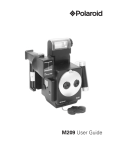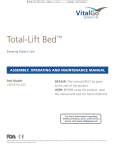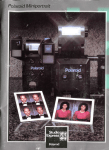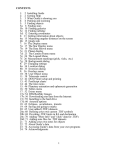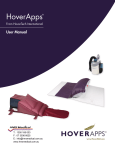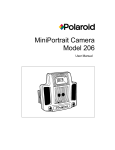Download Studio Express 485B Repair Manual
Transcript
Repair Manual Miniportrait 485B Studio ExpressCamera September 1996 Americas Business Center Technical Services 201 Burlington Road Bedford MA 01730 TEL: 1.781.386.5309 FAX: 1.781.386.5988 Table of Contents Page Section 1 - General Description ....................................................................... Camera Capabilities and Applications ............................................................. Camera Features, Controls and Parts .............................................................. Optional Accessories ........................................................................................ Specifications and Dimensions ........................................................................ 4 4 4 5 5 Section 2 - Operation ........................................................................................ Aperture Control and Selection ........................................................................ Shutter Operation and Flash Synchronization ................................................. Overall Summary ........................................................................................... Detailed Operation ......................................................................................... Four-Frame Exposure ...................................................................................... 7 7 8 8 9 11 Section 3 - Disassembly and Reassembly ...................................................... Required Tools and Materials ........................................................................... Removing and Replacing of Components ........................................................ Removing Lenses, Tape Measure, Shutter and Aperture Assemblies ........... Replacing Lenses, Tape Measure, Shutter and Aperture Assemblies ........... Removing Camera Back, Backplate and Hand Strap .................................... Replacing Camera Back, Backplate and Hand Strap .................................... 12 12 12 12 13 14 15 Disassembly/Reassembly of Sub-Assemblies .................................................. 15 Viewfinder and Hot Shoe ............................................................................... 15 Shutter Release Button .................................................................................. 19 Aperture Mechanism ...................................................................................... 20 Aperture Blades .......................................................................................... 20 Guide Plate, Click Plate or Aperture Lever ................................................. 21 Aperture and Shutter Mechanisms from the Front Panel ............................ 23 Shutter Mechanism ........................................................................................ Shutter Blades............................................................................................. Shutter Mechanism Sub-Assemblies .......................................................... Release Slide Assembly ........................................................................... Synchro (X) Switch ................................................................................... Microswitch ............................................................................................... Shutter Drive (Release Lever, Pressure Lever and Wheel Assembly ...... 24 24 26 26 26 27 27 Adjusting Flash Synchronization Contacts ....................................................... Wiring Connections and Schematic ................................................................. Camera Troubleshooting Guide ....................................................................... 29 30 31 2 List of Illustrations Figure 1-1 1-2 2-1 2-2 2-3 2-4 2-5 2-6 3-1 3-2 3-3 3-4 3-5 3-6 3-7 3-8 3-9 3-10 3-11 3-12 3-13 3-14 3-15 3-16 3-17 3-18 3-19 3-20 Page Camera Features and Controls ............................................................. Camera Outline Dimensions .................................................................. Aperture Size Determination (f\stop) ..................................................... Light Interception (A) and Shutter Blade (B) Positions .......................... Rotation of Light Interception Blade ...................................................... Shutter Blade Unlatching Action ............................................................ Wheel Cam Closure of X-sync Contacts ............................................... Optical Path/Four-Frame Exposure ....................................................... Removing Lens, Tape Measure, Aperture and Shutter .......................... Removing Camera Back ........................................................................ Removing Backplate and Handstrap ..................................................... Removing Viewfinder Object Frame ...................................................... Removing Viewfinder Cover and Lens................................................... Flash Hot Shoe Disassembly ................................................................. Shutter Release Button Disassembly .................................................... Accessing Aperture Mechanism ............................................................ Accessing Aperture Blades.................................................................... Aperture Mechanism Blade-Actuating Parts .......................................... Removing Aperture and Shutter Mechanism ......................................... Shutter Board Sub-Assembly................................................................. Shutter Blade Positions ......................................................................... Release Slide Assembly ........................................................................ Synchro (X) Switch ................................................................................ Microswitch ............................................................................................ Shutter Drive: Release Lever, Pressure Lever and Wheel Assembly ... Synchro (X) Switch Contact Adjustment ................................................ Flash Circuit Wiring Diagram ................................................................ Flash Circuit Schematic ......................................................................... 3 4 6 7 8 9 10 10 11 13 14 14 16 17 18 19 20 20 22 23 24 25 26 26 27 28 29 30 30 Section I - General Description Camera Capabilities and Applications The Polaroid Model 485B Studio Express is a hand-held or tripod-mounted camera which produces four portraits in color or black-and-white, on a single sheet of Viva film. The four portraits can be all alike, or all four can be different by selectively covering three of the lenses with lens caps each time a new portrait is taken, or the four portraits on a film sheet can be a combination of the above. Designed for European, Far Eastern, Australian and Latin American markets, the 485B is intended for indoor use by professional photographers, photo shops, government agencies and entrepreneurial photographers. (The Camera is not recommended for use outdoors.) Although low-priced, the Model 485B Studio Express is a highly reliable, quality camera specifically designed for high-volume applications. Typically, these include ID photos, government and school documents, licenses, job applications and inexpensive gift/ memento color portraits. Camera Features, Controls and Parts The 485B Studio Express has a fixed-speed, self-cocking shutter, and can be used with or without the optional accessory Model 485 Flash Unit. (A separate Service Manual is available for the 485 Flash Unit.) Figure 1 shows the camera’s features and controls. Viewfinder Flash Hot Shoe Shutter Button Hand Grip Lenses Film Processing Timer (On Back) Aperture Selector X-Sync Connector Distance Tape Tripod Socket Figure 1-1. Camera features and controls 4 Optional Accessories • Model 485 Flash Unit with two switch-selectable light output levels, for ISO 80-160 and ISO 3000 films (PID #614528). • Flash Adaptors for 120V (PID #614737) and 220V (PID #614827). • Supplementary Lenses M78V for photography at 177 cm (subject image size will be somewhat smaller than at 122 cm) (PID #614736). Specifications and Dimensions (Figure 1-2) Film Types - Viva positive color prints; ISP 160; 60-sec. development. Viva positive B&W coaterless prints; ISO 3000; 30-sec. development. Prints Per Pack/Print Size - Eight, 8.3 x 8.6 cm (3-1/4" x 3-3/8") Portrait Size - 3.6 x 3.43 cm each, of four, with Standard Lenses (1.4" x 1.35" each) Camera Size - 178cm W x 171 cm H x 152 cm D (7" W x 6.75" H x 6" D) Camera Weight - 1.1 kg (2.5 lbs.) 5 Figure 1-2. Camera outline dimensions 6 Section 2 - Operation Aperture Control and Selection (Figure 2-1) Lens apertures from f/8 to f/32 may be selected using the Aperture Indicator Knob on the right side of the Camera Front Panel. This knob is attached to the Click Plate, which slides beneath the Guide Plate. Small steel balls seated in holes in the Click Plate create detents at the five f/stop positions. As the Click Plate is moved, it forces the Aperture Lever to turn through a small arc. Pins at each end of the Lever rest in holes in each Aperture Blade, and as the Lever turns, the Blades slide over each other, moving in opposite directions. At f/8, the largest aperture, the Aperture Blades are furthest apart and the four openings (apertures) in each Blade are exactly aligned over each other, allowing maximum light to reach the film. But as the Aperture Indicator Knob is moved in the direction of smaller f/stops, the Aperture Lever causes the Blades to increasingly overlap, in turn decreasing the effective size of the four openings (apertures) in the Blades. Guide Plate Click Plate Aperture Lever Aperture Blade A Aperture Blade B Shutter Assembly Figure 2-1. Aperture size determination (f/stop) 7 Shutter Operation and Flash Synchronization Overall Summary The Shutter operates mechanically, first rotating a Light Interception Blade, then a Shutter Blade (Figure 2-2). The Light Interception Blade uncovers Baseplate openings in line with the lenses. The Shutter Blade then exposes the film as its openings sweep past the Baseplate openings. Releasing the Shutter Button returns both blades to their starting positions. Release Lever Shutter Blade B Light Intreception Blade A Film Baseplate Baseplate Rotates second to expose film. Rotates first out of image path. Lenses Figure 2-2. Light interception blade (A) and shutter blade (B) positions 8 Detailed Operations Pressing the Shutter Button pivots the Release Lever and Pressure Lever, rotating the Light Interception Blade (Figure 2-3). Although the Light Interception Blade ears no longer block the Baseplate openings, no exposure occurs because the Shutter Blade remains latched. (Figure 3-12 in Section 3 shows the left and Right Hooks engaging the Shutter Blade driving Wheel, resulting in this latching action.) Release Lever From Shutter Button Pressure Lever Light Interception Blade A Lighting Intercepting Ear Shutter Blade B Wheel Sub-Assembly Figure 2-3. Rotation of light interception blade Pressing the Shutter Button further causes the Pressure Lever to unlatch a Wheel coupled to the Shutter Blade (Figure 2-4 as well as Figure 3-20 & 21 in Section 3). The Wheel, under the tension of a compressed spring, now rotates rapidly and spins the Shutter Blade past the baseplate openings, exposing the film. When the Shutter Button is released, a spring pulls the Levers and Blades back to their original positions, and relatches the Shutter Blade. 9 Release Lever Pressure Lever Shutter Blade Wheel (Spring-coupled to Pressure Lever) Figure 2-4. Shutter blade unlatching action To synchronize flash circuit firing with the instant of maximum shutter opening, the Wheel driving the Shutter Blade has a cam lobe on its lower edge (Figure 2-5). Wheel Normally-Open Contacts Wheel Latched Cam Lobe Lower Contact Leaf B Contacts Closed by Shutter Release Wheel Unlatched Pin 0.5mm Upper Contact Leaf A Plastic Screw Figure 2-5. Wheel cam closure of X-sync Contacts As the Wheel rotates under spring force to spin the Shutter Blade, this cam lobe forces the upper X-Contact against the lower X-Contact, closing this switch. But because the cam lobe also momentarily closes the X-Contacts again on its return travel, a means must be provided to prevent a second flash firing. A microswitch 10 actuated when the Shutter Button is depressed is wired in series with the X-Contacts. When the Shutter Button is released, the Microswitch opens the circuit before the XContacts are closed a second time by the cam lobe. (Also see Figures 3-19 and 3-20 in Section 3.) Four-Frame Exposure Each release of the Shutter on a Model 485B Studio Express Camera allows light from all uncapped lenses to reach the film. If all four lenses have their caps removed, one exposure produces four identical portraits on a single sheet of Viva film. Alternatively, removing the lens caps one at a time, sequentially from each of the four lenses, will allow four different portraits to be made on a single sheet of film. Figure 2-6 diagrams the image optical path through the Model 485B. From the uncapped lens(es), the image passes through openings in the Selector Board, Aperture Assembly and Shutter Board. When the Shutter is released and the blades open, the image continues through the Shutter Plate openings, the Hood, square openings in the Camera Body and finally onto the viva film. For more details of the positions of Shutter Blades A and B when the Shutter is released, see the preceding paragraph describing Shutter operation. Shutter Plate Shutter Blades Shutter Board Aperture Assembly Selector Board Lens Board Lenses Figure 2-6. Optical path/four-frame exposure 11 Section 3 - Disassembly and Reassembly Required Tools and Materials • Phillips head driver bit #U51B, magnetized. • Wooden chuck #U51, to hold driver bit #U51B. • Thin-blade “stiletto” style tool. • Flat blade jeweler’s screwdrivers. • Small tweezers or forceps. • Curved jaw pliers with jaws taped (for removing Lenses). • Low wattage pencil-tip soldering iron. • Loctite for securing mounting screws and springs. • Black fabric adhesive tape 10mm wide, for securing wires. • Silicon grease for lubricating Aperture mechanism. Removing and Replacing Components Removing Lenses, Tape Measure, Shutter and Aperture Assemblies (Figure 3-1) 1. Unscrew the four portrait Lenses (use padded-jaw pliers, if finger torque is insufficient). Replace the Lens Caps on the Lenses to protect them against direct and scratches. 2. Lift out the Decoration Plate. 3. Peel off the cemented-on Bottom Rubber from the Bottom Plate and remove the three screws holding the Bottom Plate to the Camera Body. 4. Remove Tape Measure from double-sided tape, if necessary. 12 5. Now remove four screws holding Shutter and Aperture Assemblies to Camera Body. Access to these four screws is through holes “a” in the Lens Board (Figure 3-1). 6. Partially lift Front Panel holding the Shutter and Aperture Assemblies off Camera Body untiltwo-part connector from Hot Shoe wires is accessible on the right side. 7. Unplug the connectors, lifting the molded tab slightly on the larger connector to release them. 8. Put the Shutter and Aperture Assemblies, housed in the Front Panel, aside, with the four mounting screws. Front Panel Lens Board Decoration Plate Lens Cap “a” Connector Tape Measure Bottom Plate Bottom Rubber Figure 3-1. Removing lenses, tape measure, aperture and shutter assemblies Replacing Lenses, Tape Measure, Shutter and Aperture Assemblies Note: To reassemble or replace parts and sub-assemblies, do the Disassembly or Removal steps in reverse order, unless noted otherwise. Clean Lenses first. 13 Removing Camera Back, Backplate (Holder Frame) and Hand Strap (Figure 3-2) 1. Unlatch and open the Camera Back. Remove the eight screws mounting the Camera Back to the Backplate (Holder Frame). Camera Back Back Plate Figure 3-2. Removing camera back 2. To remove the Back Plate (Figure 3-3), remove the four screws A and two screws B securing it to the Body. Note: For reassembly, note the locations of larger screws A (corners) and smaller screws B (center). Also, don’t lose Spring C at base of Back Plate. 3. To remove the Hand Strap, remove Pins D from the Strap loops. A B A Spring C Pins D Figure 3-3. Removing backplate and hand strap 14 Replacing Camera Back, Backplate (Holder Frame) and Hand Strap Note: To reassemble or replace parts and sub-assemblies, do the Disassembly or Removal steps in reverse order, unless noted otherwise. Disassembling/Reassembling of Sub-Assemblies Viewfinder and Hot Shoe (Figures 3-4 through 3-6) Notes: • Camera Back and Backplate must first be removed. (Refer to the Removing/ Replacing procedure in this Section. • If you expect to service optical elements, wear lintless gloves to keep fingerprints off lenses. 1. To release the Eyecup, pull out its edges from the mounting channels on the Viewfinder body. (On reassembly, note that the narrower width of the Eyecup is at the top.) 2. To remove the Object Frame (Figure 3-4), first note the locking tab at the bottom of the Frame. To release this tab and the Frame from the Camera Body, tilt the body face down and look inside at the area at the base of the metal post. The Object Frame locking tab can just be seen protruding into the Camera Body. With a small, flat blade tool between the end of the tab and the metal post, gently release this locking tab and push it up through the Camera Body. 3. Now the Object Frame can be lifted straight up and off the Viewfinder housing. (Note the second tab at the top of the object Frame, which fits into the slot at the front of the Viewfinder Cover.) 15 Viewfinder Cover Release tab here with thin blade Locking Tab Slot Tab Object Frame Locking Tab Metal Post Lip on Tab Camera Body Figure 3-4. Removing viewfinder object frame 4. Now free the Viewfinder Cover by removing two screws A and the nut plate at rear, then the two screws B at the front of the Cover (Figure 3-5). 5. Gently pull up on the Cover, as far as the wiring to the Hot Shoe will allow. Remove the black tape securing the wires inside the Viewfinder, as well as the tape at three locations inside the Camera Body (Figure 3-5). 6. Push the connector through the round hole in the Body and remove the Viewfinder Cover, Hot Shoe and connected wiring, as a unit. 7. The Eyepiece Lens, Bright Frame and Object Lenses 1 and 2 are now accessible for servicing or replacement, if necessary (wear lint-free gloves). 16 B Tab Object Frame A Eyecup Viewfinder Cover Eyepiece Lens Slot Bright Frame Object Lens 2 Object Lens 1 Slot Nut Plate Tape Figure 3-5. Removing Viewfinder Cover and Lenses 8. If the Hot Shoe or its electrical connections need servicing, disassemble the Hot Shoe as follows: (Figure 3-6) • Insert the tip of a very thin blade under the Plate Spring at the point shown by the arrow, and lift slightly to release the front lip of the Plate Spring. Now slide the Plate Spring out to the rear of the Hot Shoe. • Remove the three screws C securing the Hot Shoe clip and base to the Viewfinder Cover. (Screws are attached to the Nut Plate below the Cover.) • Replacement of the wiring to the Hot Shoe can now be done, or the soldered connections checked and repaired, if necessary. 17 C Plate Spring Hot Shoe Clip Hot Shoe Base Lift here to release lip Viewfinder Cover Lip C Nut Plate Tape Figure 3-6. Flash hot shoe disassembly 18 Shutter Release Button (Figure 3-7) Note: Camera Back and Backplate must first be removed. (Refer to the Removing/ Replacing procedure in this Section.) 1. Unhook the lower end of the Spring from the Release Lever Sub-assembly tab. 2. Remove two screws A securing Counter Plat: lift off the Counter Plate with the Spring attached. 3. Lift out the Release Lever Subassembly (slide downward and lift lower end, then lift it out of Body.) It is not necessary to remove the two Spacers unless replacing them. If necessary, carefully pull them off the molded studs they are pressed onto.) 4. Remove the screw B securing the Release Button to the Release Lever. Note: To re-assemble, perform steps 1 through 4 in reverse order. Use a small amount of Loctite or equivalent under the heads of the two Counter Plate screws A and the loop ends of the Spring. Release Button Counter Plate B Body A Spring Spacer Release Lever Subassy Tabs Figure 3-7. Shutter release button disassembly 19 Aperture Mechanism Aperture Blades (Figures 3-8 and 3-9) 1. Remove the Portrait Lenses and Decoration Plate. Refer to Removing Lenses, Tape Measure, Shutter and Aperture Assemblies, steps 1 and 2 in this Section. 2. Remove the Lens Board by removing four mounting screws A (Figure 3-8). 3. Remove the Selector Board by removing four mounting screws B. 4. Remove the Aperture Indicator Knob by removing two screws C (Figure 3-9). 5. Disconnect the Aperture Spring from the Blades (unhook loops by stretching Spring). 6. Remove the Aperture Plate sub-assembly by removing four screws D. 7. Aperture Blades A and B are now accessible. Caution Before removing blades, note their orientation and order to assure correct reassembly. Aperture Indicator B Aperture Spring Aperture Plate Sub-Assy Selector Board Aperture Blades A&B A Lens Board Figure 3-8. Accessing Aperture Mechanism 20 Figure 3-9. Accessing A Guide Plate, Click Plate or Aperture Lever (Figure 3-10) 1. Remove the Lenses, Decoration Plate, Lens Board, Selector Board and Aperture Indicator Knob (See steps 1-4 in the preceding Aperture Blade procedure). 2. Remove the Guide Plate by removing its four mounting screws A. Caution Remove carefully to prevent loss of steel balls! 3. Remove steel balls and Click Plate. 4. Remove Aperture Spring (carefully pull loops out of notched Blade tabs by pulling in direction of stretching the Spring). 5. To remove the Aperture Lever and its copper bearing (poly-slider), remove the E-ring securing it to its pivot. Note: To re-assemble, perform steps 1 through 5 in reverse order. Use Loctite to secure Guide Plate mounting screws. Use silicon grease to lubricate longitudinal slot inGuide Plate. 21 Guide Plate Steel Balls Click Plates Aperture Lever Sub-Assy Aperture Spring E-ring Poly Slider (Bearing) Aperture Plate Sub-Assy Aperture Blades Figure 3-10. Aperture mechanism blade-actuating parts 22 Aperture and Shutter Mechanisms from the Front Panel 1. Remove the Front Panel containing the Aperture and Shutter Mechanisms from the Camera Body (See steps in preceding Removing and Replacing Lenses, Tape Measure, Shutter and Aperture Assemblies procedure). 2. Remove the Lens Board by removing four screws A (Figure 3-11). 3. Remove the Selector Board by removing four screws B. 4. On the Shutter mechanism side, unsolder the two blue wires from the center terminal of X (Sync) Socket (Figure 3-19). Remove hex nut and lug from Connector (black wires can be left connected to lug). 5. Remove the Aperture Indicator Knob by removing two mounting screws C. 6. Remove the Aperture and Shutter Mechanisms from the Front Panel by removing the four screws D from the Shutter Mechanisms side. Note: To re-assemble, perform steps 1 through 6 in reverse order. Use Loctite when re-installing screws D. Screws D Front Panel Screws C B Selector Board A Lens Board Figure 3-11. Removing aperture and shutter mechanism 23 Shutter Mechanism Note: Before performing any of the following steps, first remove from the Camera Body theFront Panel, which contains the Shutter and Aperture Mechanisms (See steps 1 - 7 in preceding Removing and Replacing Lenses, Tape Measure, Shutter and Aperture Assemblies procedure). Next, remove the Lens Board and Selector Board from the Aperture Mechanism side of the Front Panel (See step 2 and 3 in preceding Aperture and Shutter Mechanisms from the Front Panel procedure and Figure 3-11). Shutter Blades (Figures 3-12 and 3-13) 1. Remove the two pieces of tape securing the wires to the Shutter Board. Then open the Cable Clamp and free the wires. 2. Unsolder the blue wires from the center terminal of the X (Sync) Socket. Remove the hex nut and lug from the X (Sync) Socket. 3. From the Aperture mechanism side, remove the four screws A securing the Shutter Assembly to the Shutter Plate (Figure 3-12). Shutter Board Sub-Assy Cable Clamp Blue Wires Tape Figure 3-12. Shutter board sub-assembly 24 4. Carefully lift off the Shutter Board Sub-assembly, using care not to disturb the position of the two Shutter Blades A and B beneath the Sub-Assembly (Figure 3-13). Caution Before removing the Shutter Blades, note their order and orientation to assure correct placement when reinstalling. Figure 3-13 shows their position when the Shutter Board is removed. Note: To re-assemble, perform steps 1 through 4 in reverse order. Position Shutter Blades as shown in Figure 3-13. The pin on Wheel sub-assembly must engage with the slot W on Blade B. The pin on the Pressure Lever must engage with slot P on Blade A. Slot W for Wheel Pin Slot P for Pressure Lever Pin Blade B Blade A Figure 3-13. Shutter blade positions 25 Shutter Mechanism Sub-Assemblies (Figures 3-14 through 3-17) 1. Release Slide Assembly • Remove screws, bushings, teflon washers, release slide and second set of teflon washers. • Re-assembly, use Loctite under screw heads. Release Slide Washers Bushings Screws Figure 3-14. Release slide assembly 2. Synchro (X) Switch • Unsolder lead from upper X-contact leaf A, remove plastic screw, collar, X-contact leaf A, X-contact mount and X-contact leaf B. • Re-assemble in reverse order. Do not strip threads of plastic screw by overtightening. Be sure longer pin of the X-contact mount seats in hole in Shutter Board. Temporarily adjust contact leaves to be normally open and momentarily closed by wheel assembly when shutter is released. When satisfied that leaves are correctly positioned to fire flash, secure them with Loctite. X-Contact Mount X-Contact Leaf B X-Contact Leaf A Plastic Screw Collar Figure 3-15. Synchro (X) switch 26 3. Microswitch • Unsolder black and blue leads, remove two Switch mounting screws and washers. If necessary, remove Switch Plate by removing its two mounting screws. • Re-assemble in reverse order. If Switch Plate has been disturbed, temporarily remount it with rough side up, then mount Switch on Plate and resolder wire leads. Check that Microswitch closes before Synchro Switch closes, opens before Synchro Switch is tripped by return travel of Wheel assembly when Shutter Button is released. When satisfied with position of Microswitch, Loctite the mounting screws. Microswitch Washers Screws Switch Plate Figure 3-16. Microswitch 4. Shutter Drive (Release Lever, Pressure Lever and Wheel Assembly • First remove the Wheel Spring by removing the E-Ring, Screw and Spacer from its ends. • Next remove the Release Lever by removing the E-Ring from its pivot post. • Now remove the Pressure Lever and Release Lever Spring, below the Release Lever, by removing the E-ring from the Lever pivot pin. Use care in releasing tension of Spring. • Unhook the Spring from the Left and Right Hooks, the E-Rings securing the Hooks, and lift off both Hooks. 27 • Finally, Remove the Wheel sub-assembly by removing the E-Ring and teflon washer (Poly-Slider) on its pivot pin. • Reassemble in the reverse order. Note the following: - Place the center coil of the Release Lever Spring over the Pressure center post (plain end to the left, resting against the underside of the Release Lever pivot post, loop end to the right, hooked over the Pressure Lever. - When replacing the Release Lever, be sure the pin on its underside engages the elongated slot in the Pressure Lever. Poly-Slider (Washer) Left Hook Release Lever Spring Wheel E-ring E-rings E-ring Right Hook Pressure Lever Wheel Spring Release Lever Figure 3-17. Shutter drive: release lever, pressure lever and wheel assembly 28 Adjusting Flash Synchronization Contacts Synchro (X) Switch Contacts A and B should be normally open when no shutter action occurs, and close momentarily when the Shutter is operated. This can be checked by placing your index finger on the Wheel pin to prevent it from rotating, as the Shutter Release Button is slowly depressed. Once the Shutter mechanism is unlatched, allow the Wheel to rotate slowly and observe its cam action on the upper contact leaf of the Switch. The Wheel should deflect the upper contact leaf just enough to close and then open it. If this normally open/close/open action does not occur, loosen the plastic screw slightly at the center of the Switch and adjust the contacts appropriately. In the normally open position, the gap between contacts should be 0.5 mm. Retighten the screw and when Switch operation is correct, use a small amount of Loctite around the screw head to secure it. Caution Do not overtighten screw and strip threads. If wire leads have been removed, resolder them after the Switch is mounted on the frame. Position Switch wiring as shown in Figure 3-18, and hold it in place with two pieces of black tape 10 mm wide x 20 mm long, positioned 4 - 5 mm from the holes in the Shutter Board Assembly. Wheel Normally-Open Contacts Wheel Latched Cam Lobe Contacts Closed by Shutter Release Wheel Unlatched Pin 0.5mm Lower Contact Leaf B Upper Contact Leaf A Plastic Screw Figure 3-18. Synchro (X) switch contact adjustment 29 Wiring Connections and Schematic Interconnection of the Body Connector, Synchro (X) Switch, Microswitch and X-Sync Connector, and wire colors, are shown in Figure 3-19. Figure 3-20 is a schematic representation, depicting the function of the Microswitch to prevent flash firing a second time as the Shutter blades close. Microswitch Body Connector X (Synchro) Contacts Blue X (Sync) Connector Black Figure 3-19. Flash circuit wiring diagram Closes before X-Sync Contacts close, then opens before Wheel closes X-sync Contacts a second time on return travel. Hot Shoe X (Synchro) Contacts Close after Microswitch closes Body Connector Figure 3-20. Flash circuit schematic 30 Microswitch Troubleshooting Guide Problem Possible Causes Shutter does not release. • Shutter Button does not move. • Mechanism broken. Solution • • • • Check mechanism for jams. Spring loose/broken. Wheel does not unlatch. Pressure Lever jammed. Shutter Blades dirty. Shutter speed low, film is • See Causes above. overexposed. • Wheel Spring broken. See Solutions above. Aperture No. incorrect, film incorrectly exposed. • Aperture Control Knob does not move. Check mechanism for jam. • Blades are dirty. Check and clean Blades. • Blades incorrectly matched to number. Check and readjust blade position. • Wire broken or disconnected. • Check continuity. • Check soldered connections. • Terminal and hot shoe not connected. • Check Body Connector. • X-Contact parts broken/misadjusted. • Check gap and readjust. Microswitch not opening before X contacts close. Check Microswitch, reposition or replace. Flash does not fire. Flash fires twice. 31 Replace Wheel Spring.

































